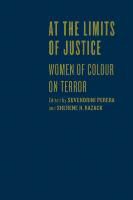Read more
Informationen zum Autor Suvendrini Perera is a professor in the Department of Communication and Cultural Studies at Curtin University. Sherene H. Razack is a professor in the Department of Humanities, Social Sciences and Social Justice Education at the Ontario Institute for Studies in Education, University of Toronto. Klappentext In At the Limits of Justice, twenty-nine contributors from six countries examine the political, social, and personal repercussions of the war on terror. Zusammenfassung In At the Limits of Justice, twenty-nine contributors from six countries examine the political, social, and personal repercussions of the war on terror. Inhaltsverzeichnis List of Illustrations Acknowledgments Introduction: At the Limits of Justice: Women of Colour on Terror (Suvendrini Perera and Sherene H. Razack) Section One: Mundane Terror/(Un)Liveable Lives Ch. 1: Introduction (Laura Kwak) Ch. 2: Violence and Terror in a Colonized Country: Canada's Indian Residential School System (Robina Thomas) Ch. 3: Terrorism and the Birthing Body in Jerusalem (Nadera Shalhoub Kevorkian) Ch. 4: The Manufacture of Torture as Public Truth: The Case of Omar Khadr (Sherene H. Razack) Ch. 5: Surveillance Effects: South Asian, Arab, and Afghan American Youth in the War on Terror (Sunaina Maira) Ch. 6: The Biopolitics of Christian Persecution (Andrea Smith) Section Two: Violence in a Far Country: Other Women's Lives Ch.7: Introduction (Roshan Jahangeer & Shaira Vadasaria) Ch. 8: "Collateral violence": Women Rights and National Security in Pakistan's War on Terror (Amina Jamal) Ch. 9: "Outsourcing Patriarchy: Feminist Encounters, transnational mediations and the crime of "Honor killings" (Inderpal Grewal) Ch. 10: Diasporas of Empire: Arab Americans and the Reverberations of War (Nadine Naber) Ch. 11: Sovereignty, War on Terror and Violence against Women (Meyda Yegenoglu) Section Three: Terror and the Limits of Remembering Ch. 12: Introduction (Kendra-Ann Pitt) Ch. 13: "Weeping is Singing": After War, a Transnational Lament (Merlinda Bobis) Ch. 14: Gone but not Forgotten: Memorial Murals, Vigils and the Politics of Popular Commemoration in Jamaica (Honor Ford Smith) Ch. 15: "Lest We Forget": Terror and the Politics of Commemoration in Guyana (Alissa Trotz) Ch. 16: "Tortured Bodies": The Biopolitics of Torture and Truth in Chile (Teresa Macias) Section Four: Thinking Humanitarianism/Thinking Terror Ch. 17: Introduction (Gulzar R. Charania) Ch. 18: From the Northern Territory Emergency Response to Stronger Futures - Where is the Evidence that Australian Aboriginal Women are Leading Self-Determining Lives? (Nicole Watson) Ch. 19: Power In/Through Speaking of Terror: The Geopolitics and Anti-Politics of Discourses on Violence in Other Places (Sedef Arat-Koc) Ch. 20: Africa, 9/11 and the Temporality and Spatiality of Race and Terror (Malinda S Smith) Ch. 21: Humanitarianism as Planetary Politics (Miriam Ticktin) Section Five: Terror Circuits Ch. 22: Introduction (Hena Tyyebi) Ch. 23: Visual Colonial Economies and Slave Death in Modernity: Bin Laden's Terror? (Anna M. Agathangelou) Ch. 24: Viewing Violence in a Far Country: Abu Ghraib and Terror's New Performativities (Suvendrini Perera) Ch. 25: Fighting Terror: Race, Sex and the Monstrosity of Islam (Sunera Thobani) Section Six: Theorizing (at) the Limits of Justice Ch. 26: Introduction (Nashwa Salem) Ch. 27: In Terror, In Love, Out of Time (Asma Abbas) Ch. 28: Radical Praxis or Knowing (at) the Limits of Justice (Denise Ferreira da Silva) Ch. 29: Unsewing My Lips, Breathing my Voice: The Spoken and Unspoken Truth of Transnational Violence (Omeima Sukkarieh) Ch. 30: Mori Cards: The Body Bags Installation (Omeima Sukkarieh) Bibliography List of Contributors ...

